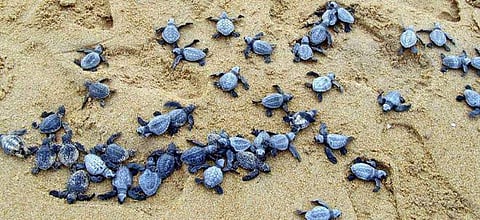The mystery behind how lower temperatures turn baby turtles into a male, unravelled
Inching closer to cracking the 50-year-old puzzle of how temperature turns baby turtles male or female, researchers have uncovered a molecular link that connects temperature with sexual development.
In turtles and other reptiles, whether an egg hatches male or female depends on the temperature of its nest.
The phenomenon was first discovered in reptiles more than 50 years ago, but until now the molecular details were a mystery.
In a study published in the journal Science, the researchers said they have finally identified a critical part of the biological "thermometer" that turns a developing turtle male or female.
The explanation lies not in the DNA sequence itself -- the A's, T's, C's and G's -- but in a molecule that affects how genes are expressed without altering the underlying genetic code, the researchers said.
"Temperature-dependent sex determination has been a puzzle for a really long time," said Blanche Capel, Professor at Duke University in North Carolina, US.
"This is the first functional evidence of a molecular link that connects temperature with sexual development," Capel said.
Unlike humans and most other mammals, the sex of many turtles, lizards and alligators is not determined by the chromosomes they inherit, but by ambient temperatures during a sensitive stage of development.
For a common pond and pet turtle called the red-eared slider, for example, eggs incubated at 32 degrees Celsius produce all female hatchlings, while those kept at 26 degrees Celsius hatch as males.
In the study, the researchers showed that cooler egg incubation temperatures turn up a key gene called Kdm6b in the turtle's immature sex organs, or gonads.
This, in turn, acts as a biological "on" switch, activating other genes that allow testes to develop.
To home in on the critical Kdm6b gene, the researchers took a group of freshly laid turtle eggs, incubated them at either 26 or 32 degrees Celsius, and looked for differences in the way genes were turned on in the turtles' gonads early in development -- before their fate as ovaries or testes has been decided.
Further experiments showed that the protein encoded by the Kdm6b gene, in turn, interacts with a region of the genome called Dmrt1, which acts as a master switch to turn on testis development.
"The next step is to find the temperature-sensing trigger," said study co-author Ceri Weber, a PhD candidate in the Capel lab at Duke.
"We're trying to narrow down the possibilities," Weber added.


